Aromatic Chemistry - Friedel-Crafts Acylation and Alkylation (A-Level Chemistry)
Friedel-Crafts Acylation and Alkylation
Friedel-Crafts Acylation
Acylation Reaction
Friedel-Crafts reactions create new C-C bonds in organic compounds.
One type of Friedel-Crafts reaction is acylation, where an RC=O group – an acyl group – is substituted for a hydrogen atom (bonded to a carbon atom) in the benzene ring.
Benzene rings are relatively stable and unreactive, so adding the acyl group can make benzene more reactive.
1. Creating the Electrophile
In order to carry out this reaction, we need an electrophile (RCO⁺) to attack the benzene ring.
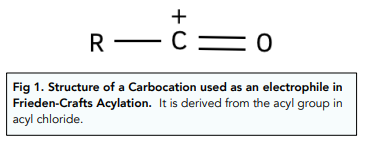
The electrophile is created using an acyl chloride and a halogen carrier, aluminium chloride:
RCHOCl + AlCl₃ → RCO⁺ + AlCl₄⁻
The electrophile is a carbocation (RCO⁺), which means it is strongly attracted to areas of high electron density – e.g. the benzene ring.

2. Electrophile Substitution into Benzene Rings
In the next step, the electrophile is substituted into the benzene ring:
1. The carbocation (electrophile) attracts electrons in the benzene ring. The carbocation uses two electrons from the benzene ring to form a bond. The benzene ring has lost electrons, so is now positively charged.
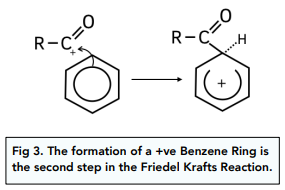
2. The AlCl₄⁻ ion is attracted to the +ve benzene ring. The AlCl₄⁻ removes a hydrogen atom, forming a phenylketone, HCl and AlCl₃. The catalyst AlCl₃ is therefore reformed.
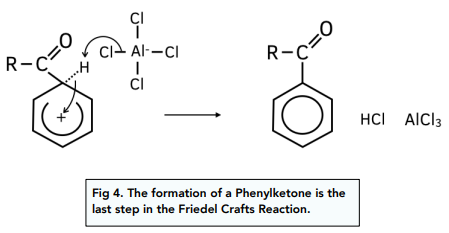
Reaction Conditions
The aluminium chloride is reformed in the reaction, which shows it acts as an catalyst.
The reactants are heated under reflux in a non-aqueous solvent like ether, for the reaction to occur.
Worked Example: Draw the reaction mechanism to form phenylethanone from benzene.
Answer:
First write the reaction to produce the electrophile CH₃CO⁺, from ethanoyl chloride and aluminium chloride
CH₃COCl + AlCl₃ → CH₃C⁺O + AlCl₄⁻
Then draw out the mechanism for the addition of the electrophile into the benzene ring. Make sure you include both steps: first the formation of the positively charged benzene ring and then the formation of the phenylketone.

Friedel-Crafts Alkylation
Another type of Friedel-Crafts reaction is alkylation, where one of the H atoms of the benzene ring is replaced for an alkyl group.
The reaction mechanism is the same as for Friedel-Crafts acylation but in this case, the electrophile is created using a halogenalkane and a halogen carrier, aluminium chloride.
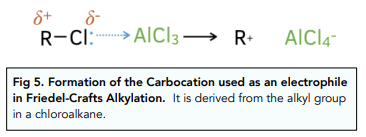
The electrophilic substitution then goes on as normal:
- Formation of a positively charged benzene ring. Two electrons are removed from the delocalised electron ring in benzene and used to form a new C-C bond. An unstable, positively charged intermediate forms.
- Removal of a hydrogen atom. A hydrogen atom is removed from the unstable intermediate by AlCl₄⁻ forming an alkylbenzene (the delocalized ring is again complete), HCl and AlCl₃.
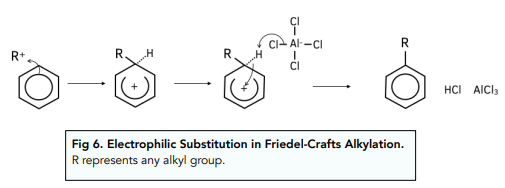
Just as in Friedel-Crafts acylation, the reactants have to be heated under reflux in a non-aqueous solvent like ether, for the reaction to occur.
Other Friedel-Crafts Alkylation Reactions
If the electrophile consists of an alkyl group that contains an OAlCl₃⁻ group, an alcohol gets formed.
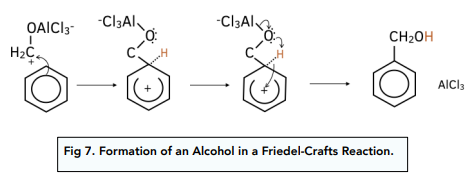
Friedel-Crafts acylation and alkylation are two important reactions in aromatic chemistry that involve the introduction of an acyl group or an alkyl group onto an aromatic ring. These reactions are important because they allow for the modification of aromatic compounds and the creation of new structures.
Friedel-Crafts acylation involves the introduction of an acyl group, such as an acetyl group, onto an aromatic ring, while Friedel-Crafts alkylation involves the introduction of an alkyl group, such as a methyl group, onto an aromatic ring.
The Friedel-Crafts acylation reaction involves the use of an acyl halide, such as acetyl chloride, and a Lewis acid catalyst, such as aluminum chloride, to introduce an acyl group onto an aromatic ring. This reaction occurs by forming a complex between the acyl halide, the Lewis acid catalyst, and the aromatic ring, which then undergoes electrophilic aromatic substitution to form the final product.
The Friedel-Crafts alkylation reaction involves the use of an alkyl halide, such as a chloromethane, and a Lewis acid catalyst, such as aluminum chloride, to introduce an alkyl group onto an aromatic ring. This reaction occurs by forming a complex between the alkyl halide, the Lewis acid catalyst, and the aromatic ring, which then undergoes electrophilic aromatic substitution to form the final product.
Friedel-Crafts acylation and alkylation have a wide range of practical applications, including the synthesis of pharmaceuticals, fragrances, and flavorings. These reactions are also used in the production of plastics, resins, and synthetic fibers.
Friedel-Crafts acylation and alkylation are important topics in A-Level Chemistry because they demonstrate the importance of aromatic chemistry in the field of organic synthesis. These reactions also illustrate the concept of electrophilic aromatic substitution and the role of Lewis acid catalysts in organic chemistry.
Common challenges and limitations of the Friedel-Crafts acylation and alkylation reactions include the formation of side products, such as polymerization, and the limitations of using Lewis acid catalysts, such as their potential to cause rearrangements and to introduce other functional groups into the product. Additionally, these reactions can be slow and require high temperatures and long reaction times, which can be limiting for some applications.






Still got a question? Leave a comment
Leave a comment